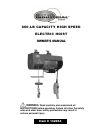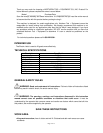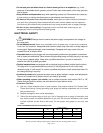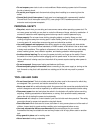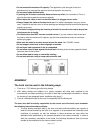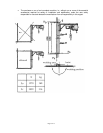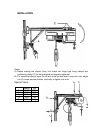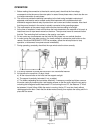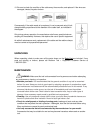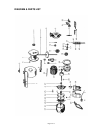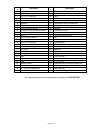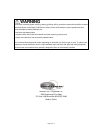Page of 13
4
• Do not expose power tools to rain or wet conditions. Water entering a power tool will increase
the risk of electric shock.
• Do not let your fingers touch the terminals of plug when installing to or removing from the
outlet.
• Ground fault circuit interrupters. If work area is not equipped with a permanently installed
Ground Fault Circuit Interrupter outlet (GFCI), use a plug-in GFCI between power tool or
extension cord and power receptacle.
PERSONAL SAFETY
• Stay alert, watch what you are doing and use common sense when operating a power tool. Do
not use a power tool while you are tired or under the influence of drugs, alcohol or medication. A
moment of inattention while operating power tools may result in serious personal injury.
• Dress properly. Do not wear loose clothing, dangling objects, or jewelry. Keep your hair,
clothing and gloves away from moving parts. Loose clothes, jewelry or long hair can be caught
in moving parts. Air vents often cover moving parts and should be avoided.
• Use safety apparel and equipment. Use safety goggles or safety glasses with side shields
which comply with current national standards, or when needed, a face shield. Use as dust mask
in dusty work conditions. This applies to all persons in the work area. Also use non-skid safety
shoes, hardhat, gloves, dust collection systems, and hearing protection when appropriate.
• Avoid accidental starting. Do not carry the power tool with your finger on the switch. Ensure
the switch is in the off position before plugging tool into power outlet. In the event of a power
failure, while a tool is being used, turn the switch off to prevent surprise starting when power is
restored.
• Do not overreach. Keep proper footing and balance at all times.
• Remove adjusting keys or wrenches before connecting to the power supply or turning on the
tool. A wrench or key that is left attached to a rotating part of the tool may result in personal
injury.
TOOL USE AND CARE
• Do not force the tool. Tools do a better and safer job when used in the manner for which they
are designed. Plan your work, and use the correct tool for the job.
• Never use a tool with a malfunctioning switch. Any power tool that cannot be controlled with the
switch is dangerous and must be repaired by an authorized service representative before using.
• Disconnect power from tool and place the switch in the locked or off position before servicing,
adjusting, installing accessories or attachments, or storing. Such preventive safety measures
reduce the risk of starting the power tool accidentally.
• Secure work with clamps or a vise instead of your hand to hold work when practical. This safety
precaution allows for proper tool operation using both hands.
• Store idle tools. When tools are not is use, store them in a dry, secure place out of the reach of
children. Inspect tools for good working condition prior to storage and before re-use.
• Use only accessories that are recommended by the manufacturer for your model.
Accessories that may be suitable for one tool may create a risk of injury when used on another
tool.
• Keep guards in place and in working order.
• Never leave tool running unattended.



